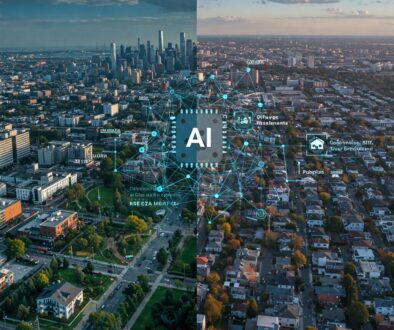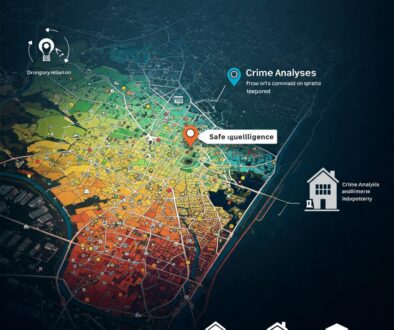Zoning Changes and Property Values: Using AI to Predict Regulatory Impact
Zoning and land use regulations are among the most significant yet frequently overlooked factors affecting real estate values. A single regulatory change can dramatically increase or decrease a property’s worth overnight, transforming development potential, permitted uses, and economic viability. For savvy investors, the ability to anticipate these changes represents a tremendous competitive advantage.
Traditional approaches to monitoring zoning changes typically rely on manual tracking of public notices, attendance at planning meetings, and relationships with local officials—methods that are time-consuming, geographically limited, and often reactive rather than predictive. In 2025, AI-powered geospatial intelligence platforms like Locas.dev are fundamentally changing this equation, enabling investors to not just track but actually predict regulatory changes with remarkable accuracy.
The Evolving Regulatory Landscape
The regulatory environment for real estate is undergoing significant transformation driven by several factors:
- Housing affordability pressures pushing many jurisdictions toward upzoning
- Climate change concerns influencing development regulations
- Transit-oriented development policies creating corridor-based zoning changes
- Economic development initiatives targeting specific growth areas
- Changing work patterns prompting mixed-use flexibility
- Infrastructure investment triggering associated zoning updates
“The pace and complexity of regulatory change have accelerated dramatically,” notes urban planner Sarah Chen. “What used to be relatively stable zoning environments now see significant updates every 2-3 years in many jurisdictions. Investors who can’t anticipate these changes are increasingly at a disadvantage.”
The Traditional Approach to Zoning Intelligence
Conventional methods for tracking regulatory changes typically involve:
- Monitoring public notices and planning agendas
- Attending community and planning meetings
- Cultivating relationships with local officials
- Hiring local consultants in target markets
- Periodically checking zoning maps for updates
This approach has several critical limitations:
- Reactive rather than predictive – Information comes after processes are already underway
- Geographically constrained – Difficult to monitor multiple jurisdictions effectively
- Resource intensive – Requires significant time and personnel
- Inconsistent coverage – Quality varies based on local relationships and resources
- Limited pattern recognition – Difficulty connecting changes across different areas
How AI Transforms Zoning and Regulatory Intelligence
Modern geospatial intelligence platforms transform this process through:
1. Policy Pattern Recognition
Traditional Approach: Investors typically evaluate each jurisdiction’s zoning approach in isolation, missing broader patterns that could predict future changes.
AI-Enhanced Approach: Advanced platforms identify policy patterns across jurisdictions:
- Cross-jurisdiction policy tracking identifying trend adoption
- Regulatory diffusion mapping showing how policies spread
- Temporal pattern analysis of how regulations evolve over time
- Political shift correlation with regulatory approaches
- Socioeconomic factor analysis driving policy decisions
Real-World Impact: “We identified a strong pattern of transit-corridor upzoning spreading across municipalities in the Pacific Northwest,” explains Michael Rodriguez of Horizon Development. “When a light rail expansion was announced in Portland, our AI platform predicted specific upzoning patterns based on what had occurred in similar circumstances in Seattle and Vancouver. We acquired several properties along the corridor 18 months before zoning changes were officially proposed, at prices that didn’t reflect their future development potential.”
2. Regulatory Change Probability Mapping
Traditional Approach: Basic understanding that certain areas might see zoning changes, but limited ability to quantify likelihood or specific nature of changes.
AI-Enhanced Approach: Sophisticated probability modeling includes:
- Change likelihood scoring across different areas
- Timeline projection for potential regulatory updates
- Specificity modeling of probable change parameters
- Catalyst identification for regulatory shifts
- Multiple scenario projection with probability weighting
Real-World Impact: An investor used regulatory probability mapping to evaluate two seemingly similar commercial properties. While traditional analysis showed comparable metrics, the AI platform identified that one property had a 78% probability of mixed-use upzoning within 36 months based on surrounding development patterns, political factors, and infrastructure investments. This property subsequently received zoning that tripled its development potential, while the alternative property remained under existing regulations.
3. Value Impact Quantification
Traditional Approach: General understanding that zoning changes affect value, but limited ability to quantify specific impacts across different scenarios.
AI-Enhanced Approach: Detailed value impact analysis includes:
- Development capacity modeling under different scenarios
- Financial impact quantification for regulatory changes
- Highest and best use recalculation under new regulations
- Transition opportunity identification during regulatory shifts
- Risk-adjusted value projection across multiple scenarios
Real-World Impact: “When analyzing a potential acquisition, our AI platform identified three possible regulatory scenarios with different probabilities,” notes Jennifer Wu of Capital Partners. “The system quantified the development potential and financial impact under each scenario, allowing us to calculate a probability-weighted value that properly accounted for regulatory upside. This analysis justified a purchase price 12% above what our conventional analysis supported—a premium that proved well worth it when the most favorable zoning scenario was adopted.”
4. Community Sentiment Analysis
Traditional Approach: Limited insight into community attitudes toward development, typically gathered through sporadic meeting attendance or anecdotal feedback.
AI-Enhanced Approach: Comprehensive sentiment intelligence includes:
- Public comment analysis across planning meetings
- Local media sentiment tracking on development issues
- Social media monitoring for development attitudes
- Community group position mapping on regulatory questions
- Demographic sentiment correlation with policy preferences
Real-World Impact: A developer was considering a project requiring zoning variances in what appeared to be a development-friendly area. While initial indicators seemed positive, AI-powered sentiment analysis identified strong organizing activity among specific community groups against similar projects, primarily on social media platforms not visible in traditional analysis. This intelligence allowed them to proactively engage with community concerns and modify their approach before facing organized opposition.
5. Political Trajectory Modeling
Traditional Approach: Basic awareness of local political dynamics but limited ability to predict how changing political landscapes might affect regulatory approaches.
AI-Enhanced Approach: Sophisticated political analysis includes:
- Electoral trend analysis and correlation with regulatory approaches
- Official voting pattern tracking on development issues
- Planning commission composition assessment
- Staff recommendation analysis and influence patterns
- Inter-jurisdictional relationship mapping
Real-World Impact: “Our AI platform identified a statistical correlation between specific planning commission changes and subsequent regulatory approaches,” explains David Chen of Urban Investments. “When commission appointments in our target market shifted toward individuals with backgrounds similar to those in other jurisdictions that had recently upzoned, we accelerated our acquisition timeline for transit-adjacent properties. Within 14 months, the commission initiated exactly the type of zoning changes our model predicted.”
Case Study: The Westside Corridor Transformation
When Meridian Development was evaluating opportunities in a mid-sized Western city, they employed both traditional analysis and AI-powered regulatory intelligence:
Traditional Assessment:
- Current zoning allowed limited commercial and medium-density residential
- No pending zoning changes discovered in public notices
- Local officials indicated no immediate plans for regulatory updates
- Recent development followed existing zoning patterns
- Comparable sales reflected current zoning values
AI-Enhanced Intelligence:
- 73% probability of transit-oriented upzoning within 24-36 months
- Pattern recognition identified early-stage indicators matching pre-upzoning conditions in similar corridors
- Political composition analysis showed shifting attitudes toward density
- Multiple infrastructure investments identified as likely regulatory catalysts
- Community sentiment analysis revealed growing support for housing density
Based on this intelligence, Meridian:
- Acquired four strategic properties along the corridor at prices reflecting current zoning
- Structured acquisitions with extended closing timelines on two additional properties
- Developed preliminary plans for both current and potential future zoning
- Established relationships with key community stakeholders
- Created a phased development approach adaptable to regulatory changes
Within 28 months, the city announced a transit-oriented development overlay exactly as the AI model had predicted, allowing significantly higher density and mixed-use development. Properties along the corridor saw value increases of 30-45%, with Meridian’s strategically selected sites achieving the highest appreciation due to their specific characteristics identified by the AI platform.
Key Factors in Predicting Regulatory Changes
Modern geospatial intelligence platforms analyze several critical factors to predict zoning and regulatory evolution:
1. Political and Policy Patterns
- Electoral shifts and their historical correlation with regulatory approaches
- Planning department leadership changes and their potential impact
- Policy precedents from politically similar jurisdictions
- Regulatory reform initiatives at different governmental levels
- Political pressure points around housing, transportation, and development
2. Economic and Market Pressures
- Housing affordability metrics and their relationship to upzoning pressure
- Economic development initiatives targeting specific areas
- Market demand-regulation misalignment creating pressure for change
- Development activity clustering near regulatory boundaries
- Investment patterns preceding regulatory shifts
3. Infrastructure and Public Investment
- Transportation infrastructure planning and its zoning implications
- Public facility investment signaling development priority areas
- Utility capacity upgrades enabling increased density
- Public space investments correlating with regulatory enhancements
- Smart city initiatives with associated zoning modernization
4. Demographic and Social Factors
- Population growth patterns creating housing pressure
- Changing household composition affecting housing type demand
- Generational preference shifts in housing and neighborhood types
- Employment pattern evolution influencing work-housing relationships
- Lifestyle preference changes affecting mixed-use demand
5. Environmental and Resilience Considerations
- Climate action plan implementation affecting development regulations
- Resilience strategy adoption influencing permitted areas and types
- Sustainability initiative correlation with regulatory approaches
- Environmental justice considerations in zoning equity
- Green infrastructure integration with development requirements
Implementing Regulatory Intelligence in Your Investment Strategy
To leverage these powerful insights for your real estate investments:
1. Adopt a Probability-Based Approach
Rather than viewing zoning as fixed or changes as unpredictable, implement a probability-weighted approach:
- Evaluate multiple potential regulatory scenarios
- Assign likelihood percentages to different outcomes
- Calculate value impacts under different scenarios
- Make acquisition decisions based on probability-adjusted potential
- Structure deals to capture upside while mitigating downside
2. Target Regulatory Transition Zones
Identify areas with highest probability of positive regulatory change:
- Transit corridor expansion areas
- Underutilized zones adjacent to high-demand districts
- Areas with significant infrastructure investment
- Districts with obsolete zoning relative to market demand
- Neighborhoods with demographic shifts favoring regulatory evolution
3. Structure Acquisitions to Capture Regulatory Upside
Design purchase approaches that maximize regulatory opportunity:
- Option agreements with extended timeframes
- Phased closings tied to regulatory milestones
- Seller participation structures sharing regulatory upside
- Contingent development rights provisions
- Joint ventures with regulatory milestone distributions
4. Proactively Engage in Shaping Regulations
Use regulatory intelligence to participate constructively in the planning process:
- Identify opportunities to align development goals with community needs
- Participate in planning processes with data-backed proposals
- Form strategic alliances with aligned stakeholders
- Develop projects that serve as positive precedents
- Contribute constructively to regulatory evolution
5. Build Adaptable Development Approaches
Create development strategies that can evolve with regulatory changes:
- Design for potential future density increases
- Plan infrastructure with expansion capacity
- Consider phasing strategies adaptable to regulatory evolution
- Incorporate flexible spaces convertible to different uses
- Balance current returns with future regulatory optionality
The Future of Regulatory Intelligence
As AI and geospatial intelligence continue to evolve, several emerging capabilities promise even more sophisticated regulatory prediction:
Real-time Regulatory Monitoring
Future systems will provide continuous real-time tracking of regulatory indicators, instantly identifying new signals that might affect probability projections.
Regulatory Opportunity Matching
Advanced platforms will automatically match your specific investment criteria with areas showing high probability of favorable regulatory changes aligned with your strategy.
Proactive Regulatory Strategy Recommendations
AI will suggest specific approaches to constructively engage with regulatory processes, identifying opportunities to align your development goals with community and policy objectives.
Integrated Regulatory-Financial Modeling
Future systems will seamlessly integrate regulatory probability analysis with financial modeling, allowing real-time testing of how different regulatory scenarios affect project returns.
Collaborative Intelligence Networks
Platforms will enable anonymized sharing of regulatory intelligence across investor networks, creating more comprehensive pattern recognition while maintaining individual competitive advantages.
Conclusion: From Regulatory Risk to Strategic Opportunity
Zoning and regulatory changes remain one of the most significant factors affecting real estate values. The evolution from reactive tracking to predictive intelligence represents a transformative opportunity for investors to:
- Identify properties with unpriced regulatory upside
- Make more confident acquisition decisions with probability-weighted analysis
- Time market entries and exits around regulatory cycles
- Structure deals to capture regulatory value creation
- Engage constructively in planning processes with data-backed approaches
As regulatory environments become increasingly dynamic, the competitive advantage will increasingly belong to investors who can not just respond to changes but anticipate them with sophisticated intelligence.
Ready to transform regulatory uncertainty into strategic opportunity? Try Locas.dev today and experience the power of AI-driven regulatory intelligence for your real estate investments.
This article reflects the current state of AI technology in regulatory intelligence for real estate. For the latest updates and features, visit Locas.dev.
Keywords: zoning change prediction, property value regulatory impact, real estate zoning intelligence, AI regulatory analysis, property upzoning prediction, land use regulation AI, zoning change property value



